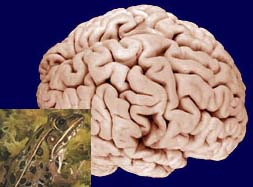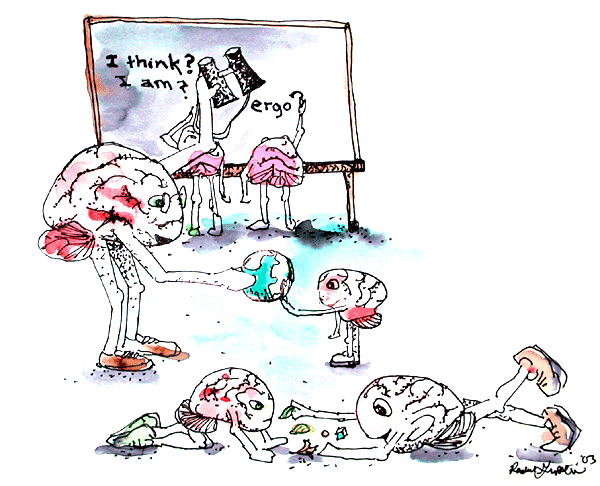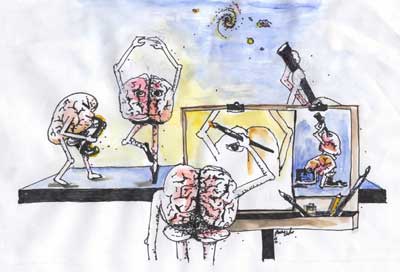Serendip is an independent site partnering with faculty at multiple colleges and universities around the world. Happy exploring!
Brain Behavior Institute 2009 - Home
Brain and Behavior Institute 2009
 |
 |
 |
| Welcome to the home page of the Brain and Behavior Institute at Bryn Mawr College for the year 2009. This Institute (like others in the series) is designed to bring together college faculty and K-12 teachers to discuss current understandings of brain function in relation to behavior ... and the implications of those understandings for classroom teaching and education generally. The Institute, which runs from 6 July to 17 July, is supported by a grant to Bryn Mawr College from the Howard Hughes Medical Institute and by the Bryn Mawr/Haverford K-16 Collaborations in Science and Mathematics Education and the Serendip website. | ||
|
"Science has the potential to be what we all collectively need as we evolve into a world wide community: a nexus point that encourages and supports the evolution of shared human stories of exploration and growth, an evolution in which all human beings are involved and take pride." - Revisiting Science in Culture See also |
"For the first time in human history, it is becoming possible to achieve optimal educational environments for all human beings. The web can provide the needed richness, interactivity, and room to explore in a cooperative and collaborative mode." - Serendip Credo on Education and Technology
|
The Brain - is wider than the Sky - Emily Dickinson (1830-1886)
See also
|
|
 |





Comments
what did I say?
While teaching often I wonder what I said or did to achieve the response that I had obtained, it never really occurred to me that I did not add an input that gained the response I had received. How often have we been in a disagreement with a friend or family member and wondered where you receive the comment or response you felt was completely different than you expected? It would be interesting to learn how to better adapt to the responses of others.
Good point of question.
Good point of question. Sometimes we need also think of the "what did I hear?" As well as what it is we are saying.
what did I say?
Normal
0
false
false
false
EN-US
X-NONE
X-NONE
MicrosoftInternetExplorer4
/* Style Definitions */
table.MsoNormalTable
{mso-style-name:"Table Normal";
mso-tstyle-rowband-size:0;
mso-tstyle-colband-size:0;
mso-style-noshow:yes;
mso-style-priority:99;
mso-style-qformat:yes;
mso-style-parent:"";
mso-padding-alt:0in 5.4pt 0in 5.4pt;
mso-para-margin-top:0in;
mso-para-margin-right:0in;
mso-para-margin-bottom:10.0pt;
mso-para-margin-left:0in;
line-height:115%;
mso-pagination:widow-orphan;
font-size:11.0pt;
font-family:"Calibri","sans-serif";
mso-ascii-font-family:Calibri;
mso-ascii-theme-font:minor-latin;
mso-fareast-font-family:"Times New Roman";
mso-fareast-theme-font:minor-fareast;
mso-hansi-font-family:Calibri;
mso-hansi-theme-font:minor-latin;}
While teaching often I wonder what I said or did to achieve the response that I had obtained, it never really occurred to me that I did not add an input that gained the response I had received. How often have we been in a disagreement with a friend or family member and wondered where you receive the comment or response you felt was completely different than you expected? It would be interesting to learn how to better adapt to the responses of others.
what did I say?
Normal
0
false
false
false
EN-US
X-NONE
X-NONE
MicrosoftInternetExplorer4
/* Style Definitions */
table.MsoNormalTable
{mso-style-name:"Table Normal";
mso-tstyle-rowband-size:0;
mso-tstyle-colband-size:0;
mso-style-noshow:yes;
mso-style-priority:99;
mso-style-qformat:yes;
mso-style-parent:"";
mso-padding-alt:0in 5.4pt 0in 5.4pt;
mso-para-margin-top:0in;
mso-para-margin-right:0in;
mso-para-margin-bottom:10.0pt;
mso-para-margin-left:0in;
line-height:115%;
mso-pagination:widow-orphan;
font-size:11.0pt;
font-family:"Calibri","sans-serif";
mso-ascii-font-family:Calibri;
mso-ascii-theme-font:minor-latin;
mso-fareast-font-family:"Times New Roman";
mso-fareast-theme-font:minor-fareast;
mso-hansi-font-family:Calibri;
mso-hansi-theme-font:minor-latin;}
While teaching often I wonder what I said or did to achieve the response that I had obtained, it never really occurred to me that I did not add an input that gained the response I had received. How often have we been in a disagreement with a friend or family member and wondered where you receive the comment or response you felt was completely different than you expected? It would be interesting to learn how to better adapt to the responses of others.
OCD and Paul's new brain model
What about this new model of the brain. Why do people who have OCD's exhibit their unwanted behaviors? Is it possible that it's just an output by itself? I've heard that it's a chemical in the brain that causes unwanted actions, but I think it's influenced by environmental factors too... aren't these inputs? When upset or stressed the behaviors are more pronounced- are these part of who we are? Are these just another part of our brain?
I guess you could say that since our brain is the origin of all of our thoughts and all of our actions are only possible after signals are originated in the brain, that WE ARE OUR BRAIN.
7/7 AM # Queries
1. How do the left and right brain integrate, thus making us who we are?
2. How to they balance, thus making us who we are?
3. Do they ever balance 50 - 50, 40 - 60, thus making us who we are? AND does the balance 100 - 100 exsist or is this perfection?
06JUL09 pm session
This afternoon’s session was not nearly as confusing as previous first day’s sessions. The Game of Life simulation demonstrated that seemingly complex results can come from very simple rules. It does not however mean that all complexities have come from seemingly simple rules. Complexities in origins of behavior and learning are more complex than simply viewing red and green dots on a computer screen. As an educator, I must remember that 5 – 4 may cause students to recall more emotional responses than considering basic mathematical computations. What I view as a simple request “bring back the reading homework” may have complex interferences…the student’s and the parent’s view of education, homework and ect.
Langston’s Ant still bothers me. Although the rules are very simple, the ant is programmed to do the same thing, after 11,000 steps, the un-hindered ‘ant’ will build a bridge. Adding the barrier only ‘allows’ the ant to interact with it’s environment. Yet, the ant in the program continues to follow the same pattern, following the two internal rules. When people in the natural world interact with their environment, they rarely follow the exact same pattern in response to changes. The original complex looking pattern is really a simple one that will yield the same results, if un-hindered. In all of my years of teaching, both academically, and as a Bible school teacher, have I ever had the exact same result to similar lessons. Because people tend to respond in creative ways, The Langston’s Ant program bothers me… as I am not sure what it is trying to prove.
First Day Morning Reflection
The three words I thought of when I heard the word- SCIENCE were, learning-animals-earth.
This morning I was exposed to the idea that the conclusions we reach in experimentation are not finalities. We may find out that the hypothesis is right or wrong, but that is not the end of the process. We will find more observations and make summaries of these observations pushing along our thoughts in countless directions. Paul said that the brain is not happy with consistency...it's actually what summary you can conclude that will take you to your next question. I loved hearing that when we were babies we were experimenting, and creating summaries... this makes a lot of sense to me because the only way babies learn is by doing- the same concept I prefer to have my students using to master science learning.
Post new comment